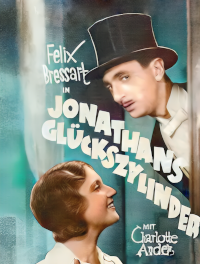
Original Title: Goldblondes Mädchen, ich schenk’ dir mein Herz. (Ich bin ja so verliebt. Jonathan’s Glückszylinder.) Musical farce 1932; 89 min.; Director: Rudolf Bernauer; Cast: Felix Bressart, Charlotte Ander, Oskar Sima, Adele Sandrock, Karl Meinhardt, Margo Lion, Hans Zesch-Ballot, Max Ehrlich, Paul Heidemann, Senta Söneland, Hans Leibelt, Julius Falkenstein; Elite-Tobis-Klangfilm.
A small civil servant wants to lend a hand to a colleague without a position and gets involved in an adulterous affair due to a swapped top hat. He ends up being suspected by his colleague and boss of being a secret lover, which costs him his job, until a film engagement relieves him of all worries.
Summary
Gottfried Jonathan, a small civil servant, lives as a lodger and is roommates with the blonde Käthe. Although she tries very hard, she can’t find a job and can no longer afford her rent of 40 marks. For this reason, the landlady asks her to move out the next morning.
Jonathan secretly loves Käthe and decides to raise the necessary money for her. While his attempt to retrieve a hidden sum fails, he is offered an extra role in a film where he is supposed to portray a ballroom guest wearing a tailcoat and top hat.
However, due to an unfortunate accident, the top hat ends up under a car and gets run over. In his desperation, Jonathan now steals the top hat of a man sleeping on a park bench, but it’s too small for him. When he examines the hat more closely, he finds a note with a suicide threat from a lady named Olga to someone named Fredi, whom he doesn’t know. In the note, she asks him to meet her at the “Pompadour Bar” to kidnap her.
Jonathan wants to prevent a tragedy and visits the bar right after the filming. Here, he manages to locate Olga and inform her husband, the writer Delius, by telephone. Just as he is about to leave the bar, he sees his boss together with Käthe and hides in a private booth. Shortly after, he witnesses his boss making advances towards Käthe. However, when he tries to become too forward, she tells him that she loves Jonathan and leaves the booth.
Happily hearing what just transpired, Jonathan drinks himself silly with the leftover champagne and then proceeds to make a spectacle of himself with various musical instruments, causing Käthe to want nothing more to do with him. Turbulence and misunderstandings ensue, but they turn out for the better when Jonathan receives a lucrative film offer because the director liked his recordings. Now, Jonathan and Käthe become a couple.
j-n.s review in Film Kurier No. 196 (August 20, 1932)
Felix Bressart is the one deeply in love. His affection is directed towards a petite “furnished” office girl who is unemployed and shares the same landlady as him. To make matters worse, she owes 40 marks in rent.
These 40 marks become the focal point of the story, as Bressart navigates his way through various twists and turns. Despite being a mere office employee, he takes risks and delivers grandiose remarks, unleashing a torrent of witty wordplay.
In exchange for these 40 marks, he is offered a role as an extra in a film shoot. He portrays a gentleman in a tailcoat, which he has to borrow. However, these 40 marks become the catalyst for a series of misunderstandings, as convoluted as Bressart’s complex sentences and unorthodox wordplay, defying all rules of grammar like a chain of dominoes.
In the end, he succeeds, although not in the film he initially intended. The producer is enthralled by his long legs and secures his happiness with a three-year contract.
This film stands on shaky ground, with the legs metaphorically representing its instability. The narrative often meanders in various directions, as if caught in a whirlwind, leaving director Rudolf Bernauer with little work to do.
While Bressart may not find joy in the act of filming itself, he undoubtedly experiences it while performing. His emotions are unclouded, and a director should recognize this and, if not enhance, at least ration his delivery. The impact of his verbal cascades would undoubtedly be even greater and more precise.
Once again, it is proven that Bressart captivates audiences. His most effective moments occur when his facial expressions are seemingly devoid of intent. His almost indifferent yet submissive demeanor, combined with a few helpless words that seem to escape his control, evoke laughter and draw the audience closer.
Bressart’s partner in the film is Charlotte Ander, a sympathetic and resolute young woman. She dismisses half-hearted advances as decisively as directors who meticulously examine themselves before hiring typists. Oskar Sima, in his role as a director, showcases his versatility, while Adele Sandrock, styled as a strong-willed woman, complements his (Sima’s) feigned innocence.
Marga Lion and Senta Söneland, well-defined characters, add depth to the ensemble, skillfully captured through Winterstein and Balasch’s photography and acoustically enhanced by Fritz Seeger.
The audience enthusiastically embraces the popular song “Goldblondes Mädchen, ich schenk Dir mein Herz” from Granichstaedten’s music.
This film, which garnered many laughs, is partly based on the comedy by Jacobsohn and Oestreicher.